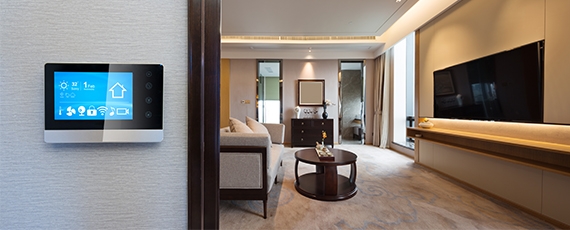Turn Your House into a Smart Home

Your wish can now become your smart home’s command. Smart TVs, thermostats, security systems, and even smart refrigerators, washers, and dryers are moving in and becoming a part of our daily lives. Our devices no longer need us to be the middle man; they can talk to each other directly. When the alarm on your smartphone goes off in the morning, it can tell your coffee maker to start brewing. Your smart refrigerator can sense when the milk is low and add it to the grocery list on your smartphone. Depending on the devices you own, the possibilities really are endless!
At first, smart homes were managed using a closed computer system — meaning the lights, furnace, air conditioning, security system, and more were managed by a local computer, which contained software that did not need access to the internet. But as our lives have become increasingly mobile, the need to have control on the go became necessary.
Household appliances are the fastest-growing category of devices being connected to the Internet of Things (IoT). Think of how many people live in your home versus the number of internet-connected devices that live in your home. The IoT has potentially taken over without you realizing it.
As technology takes a seat at the table, it is quickly becoming an important part of how our homes function. The convenience of smart home technology can be hard to resist, but it’s important to stop and consider the risks of having multiple devices communicating on your home network.
Home is Where the Hub is
With each new smart home device comes a new app and remote control. But who wants a different remote control and app for every single connected device in their home? This is where smart hubs come into play. Whether you are talking to Siri, Cortana, or Alexa, a smart hub uses a centralized app to wirelessly control all of the connected devices in your home.
As simple as that sounds, it can get complicated quickly. You may need to purchase your smart home devices from the same manufacturer to make sure they connect and communicate with each other correctly. But preventing communication can be just as important as facilitating it — children have been known to accidentally order toys and cookies from Amazon’s Alexa, leaving mom and dad with an unexpected bill.
Privacy and security concerns can also increase with each device you add to your network. As you are interacting with an individual device, it learns your preferences and habits, which it can then share with other devices or even the manufacturer. There are several important privacy and security issues to keep in mind when adding devices to your home network:
Too Much Data – The more connected our devices become, the more data they can collect about us. The Federal Trade Commission (FTC) estimates that a single household can generate one data point every six seconds.
Unwanted Profiles – With each new device and app comes a new username, password, and terms of service. Make sure you know exactly what data the manufacturer is collecting from your devices and how they are using it.
Eavesdropping – Limited security features in IoT devices often make them easy for hackers to access. They can virtually invade your home through the webcam on your smart TV or malware on your computer.
A Hacking Highway – Having all of your devices continuously connected to each other could expose your entire home network to hackers. An online security breach of one device opens the door to all the other devices connected to it.
Do Some Homework on Your Smart Home
When you consider new smart devices for your home, make sure to ask some important questions to determine whether these devices may or may not be right for you and your family. How does the device work? What support does the manufacturer provide? What are the product’s security features?
The FTC offers tips as you add to the number of smart devices in your home:
Find out if the product will work with devices you already own or with other companies’ devices.
Ask how you will get security and other product updates.
Take time during the initial setup of each device to familiarize yourself with any dashboards and widgets that you will use to control the device remotely.
Don’t just accept default settings. Always change default passwords and turn on security features. Re-evaluate only after you are familiar with the device.
Consider if you will be able to keep using the device if the manufacturer stops providing updates and other support.
It is important to be proactive in protecting your smart devices, your home, and your personal information from cyber risks. A home cyber security audit can identify and help manage vulnerable areas of your home network, devices, security, and usage. Along the same line, a social engineering assessment analyzes the publicly available personal information that exists online about you and your family. With this type of analysis, you can predict how this information can be used against you and make changes to help mitigate threats. There are also monitoring services designed to detect and respond to hacking attempts on your home network.
Doing a little investigating into how your IoT home devices are set up and how you are sharing your information can go a long way in protecting yourself against cyber threats.
Resources
ftc.gov
riskconversation.com
businessinsider.com

